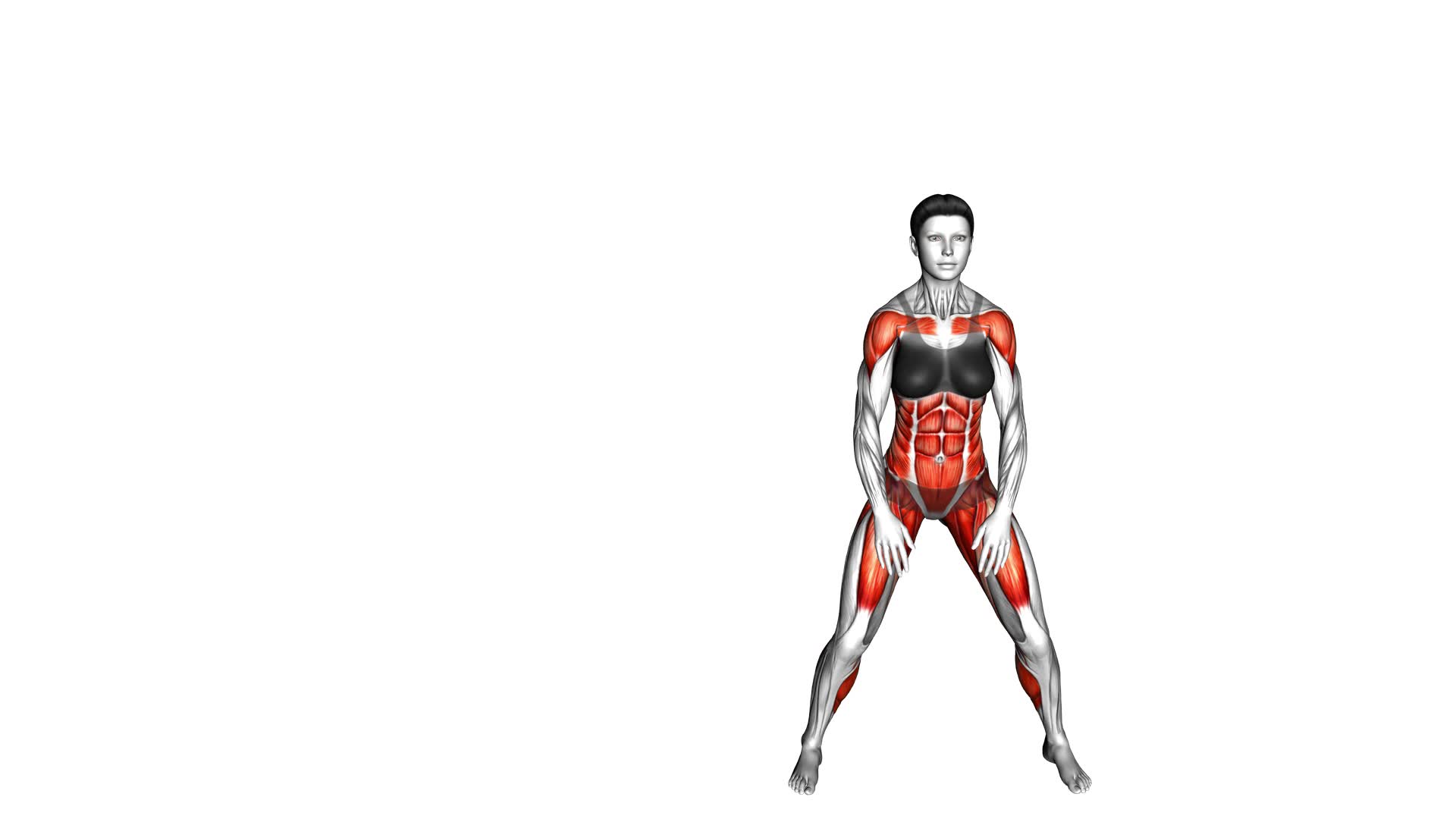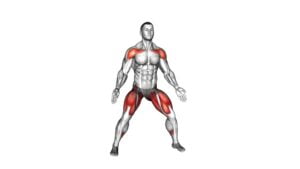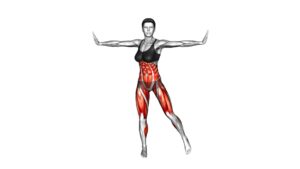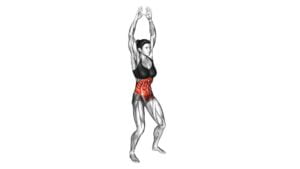Hands-up Side Step (female) – Video Exercise Guide & Tips

Are you looking for a new exercise to add to your routine? Look no further than the hands-up side step!
Watch This Exercise Video
This video exercise guide and tips will help you perfect your form and technique, whether you're a beginner or advanced.
With modifications and advanced variations, you can challenge yourself and take your fitness to the next level.
Get ready to incorporate the hands-up side step into your workout routine and see the results you've been striving for.
Key Takeaways
- Hands-up side step exercise is suitable for individuals of all fitness levels.
- The exercise targets and strengthens various muscles including the gluteal muscles, quadriceps, hamstrings, calf muscles, and core muscles.
- The intensity of the exercise can be increased by using resistance bands or weights, performing it on an unstable surface, or incorporating lateral jumps.
- Proper form and technique, such as maintaining a neutral spine, aligning knees with toes, and engaging core muscles, should be followed to maximize benefits and minimize impact on joints.
Benefits of the Hands-up Side Step
To maximize the effectiveness of your workout routine, it's important to understand the benefits that the hands-up side step exercise can provide. This exercise is a great way to improve your cardiovascular health and increase lower body strength.
When performing the hands-up side step, you're engaging multiple muscle groups in your lower body, including your glutes, quadriceps, and hamstrings. The side-to-side movement helps to strengthen these muscles, leading to improved overall lower body strength.
In addition to building strength, the hands-up side step also provides a cardiovascular workout. The continuous movement and increased heart rate during this exercise can help to improve your cardiovascular health. Regularly incorporating this exercise into your routine can lead to increased endurance and a healthier heart.
To perform the hands-up side step, start by standing with your feet shoulder-width apart. Raise your hands up to shoulder level, keeping your elbows bent. Step to the side with your right foot, followed by your left foot. Continue stepping side to side, maintaining a steady pace. Remember to keep your core engaged and maintain proper form throughout the exercise.
Incorporating the hands-up side step into your workout routine can provide numerous benefits, including improved cardiovascular health and increased lower body strength. So, why not give it a try and start reaping the rewards today?
Proper Form and Technique
Maintain proper form and technique while performing the hands-up side step exercise to maximize its benefits and prevent injury. Here are three important tips to help you execute this exercise correctly:
- Keep your back straight:
- Maintaining a neutral spine is crucial to prevent strain on your lower back.
- Engage your core muscles and avoid leaning forward or backward during the side step movement.
- This will ensure that your back remains properly aligned throughout the exercise.
- Step wide and controlled:
- When performing the side step, take wide steps to engage your glutes and outer thighs effectively.
- Avoid rushing through the movement and focus on the control of each step.
- This will help you maintain proper balance and stability throughout the exercise.
- Keep your knees aligned:
- It's important to ensure that your knees are in line with your toes during the side step.
- Avoid letting your knees collapse inward, as this can put excessive stress on your knee joints and increase the risk of injury.
- Keep your knees facing forward and aligned with your toes throughout the exercise.
Modifications for Beginners
If you're new to the hands-up side step exercise, there are modifications you can try to make it more beginner-friendly. These modifications are designed to help you build strength, coordination, and balance while gradually increasing the intensity of the exercise.
One common modification for beginners is to perform the side steps without raising your arms above your head. Instead, keep your hands at your sides or place them on your hips to maintain stability. This will reduce the strain on your upper body and allow you to focus on the lower body movement.
Another modification is to decrease the range of motion when stepping to the side. Start with smaller steps and gradually increase the distance as you become more comfortable and confident with the exercise. This will help you develop proper form and technique while minimizing the risk of injury.
It's important to avoid common mistakes that beginners often make during the hands-up side step exercise. One common mistake is allowing your knees to collapse inward when stepping to the side. Keep your knees aligned with your toes to maintain proper alignment and prevent strain on the knees. Another mistake is rushing through the exercise without engaging your core muscles. Remember to engage your core and maintain a controlled movement throughout the exercise.
Advanced Variations to Challenge Yourself
Challenge yourself with advanced variations of the hands-up side step exercise to take your fitness level to the next level. Here are three advanced modifications and alternative exercises that will push your limits and help you achieve even greater results:
- Resistance Band Side Step: Attach a resistance band around your ankles and perform the side step. The resistance band adds extra tension, challenging your muscles and increasing the intensity of the exercise.
- Speed Skaters: Instead of stepping to the side, perform a jumping motion, leaping from one side to the other. This exercise not only works your lower body but also improves your cardiovascular endurance and agility.
- Weighted Side Step: Hold a dumbbell or kettlebell in each hand while performing the side step. The added weight increases the resistance, making your muscles work harder and promoting strength gains.
By incorporating these advanced modifications and alternative exercises into your workout routine, you'll continue to challenge your body and prevent plateaus.
Remember to always maintain proper form and listen to your body to avoid injury. Push yourself, but also listen to your limits and progress at your own pace.
Keep pushing forward and enjoy the rewarding feeling of achieving new fitness milestones.
Tips for Incorporating the Hands-Up Side Step Into Your Workout Routine
To incorporate the hands-up side step into your workout routine, consider adding it as a dynamic warm-up exercise before your main workout. This exercise is great for incorporating cardio and improving coordination.
Begin by standing with your feet hip-width apart, arms extended out to the sides at shoulder height. Engage your core and keep your back straight throughout the exercise.
Start by taking a step to the right with your right foot, simultaneously lifting your left foot off the ground and bringing your left knee up towards your chest. As you step to the right, bring your arms up overhead, keeping them slightly bent at the elbows.
Next, step your left foot to the right, bringing your right knee up towards your chest and lowering your arms back down to shoulder height. Continue this side-to-side stepping motion, alternating knees and arms as you go.
Remember to maintain a steady pace and keep your movements controlled. Focus on staying light on your feet and engaging your core muscles to maintain balance and stability.
Incorporating the hands-up side step into your workout routine can help increase your heart rate and warm up your muscles, preparing your body for a more intense workout. Additionally, it can improve coordination and balance, making it a beneficial exercise for people of all fitness levels.
Frequently Asked Questions
How Many Calories Can You Burn by Doing the Hands-Up Side Step?
You can burn a significant amount of calories by doing the hands-up side step. This exercise involves moving your arms up and down while stepping sideways. It's a great way to get your heart rate up and burn calories.
If you have knee issues, there are modifications you can make to reduce the impact on your knees. Remember to always listen to your body and consult with a professional if needed.
Can the Hands-Up Side Step Help Improve Balance and Coordination?
Improving stability and coordination is key to a balanced fitness routine. The hands-up side step can definitely help you achieve these goals.
By engaging your core and lower body muscles, this exercise challenges your balance and coordination.
The repetitive side-to-side movements not only strengthen your muscles, but also train your body to move in a coordinated manner.
Is It Necessary to Use Hand Weights While Performing the Hands-Up Side Step?
Using hand weights for the hands-up side step can enhance the workout intensity and strengthen your upper body. While it isn't necessary to use hand weights, incorporating them into your routine can provide additional resistance and help you achieve better results.
Can the Hands-Up Side Step Be Modified for Individuals With Knee or Joint Issues?
If you have knee or joint issues, you might be wondering if there are modified modifications or alternative exercises for the hands-up side step. Well, the good news is that there are options available!
It's important to prioritize your safety and comfort when working out. You can consult with a fitness professional or physical therapist who can provide you with specific modifications tailored to your needs.
Don't hesitate to ask for guidance and find exercises that work for you.
How Often Should the Hands-Up Side Step Be Included in a Weekly Workout Routine for Optimal Results?
To achieve optimal results, it's important to include the hands-up side step in your weekly workout routine. This exercise offers great calorie burning benefits and can help you tone your body.
By incorporating variations for beginners, you can gradually increase the intensity and challenge yourself as you progress. Make sure to consult with a fitness professional to ensure proper form and technique.
Aim to do this exercise at least 2-3 times a week for best results.
Conclusion
In conclusion, the hands-up side step is a beneficial exercise that can be easily incorporated into your workout routine. By following proper form and technique, you can strengthen your lower body and improve your balance and coordination.
Beginners can modify the exercise to suit their fitness level, while advanced variations provide a challenge for those seeking to push themselves further.
With these tips and guidelines, you can confidently add the hands-up side step to your fitness regimen.

Author
Years ago, the spark of my life’s passion ignited in my mind the moment I stepped into the local gym for the first time. The inaugural bead of perspiration, the initial endeavor, the very first surge of endorphins, and a sense of pride that washed over me post-workout marked the beginning of my deep-seated interest in strength sports, fitness, and sports nutrition. This very curiosity blossomed rapidly into a profound fascination, propelling me to earn a Master’s degree in Physical Education from the Academy of Physical Education in Krakow, followed by a Sports Manager diploma from the Jagiellonian University. My journey of growth led me to gain more specialized qualifications, such as being a certified personal trainer with a focus on sports dietetics, a lifeguard, and an instructor for wellness and corrective gymnastics. Theoretical knowledge paired seamlessly with practical experience, reinforcing my belief that the transformation of individuals under my guidance was also a reflection of my personal growth. This belief holds true even today. Each day, I strive to push the boundaries and explore new realms. These realms gently elevate me to greater heights. The unique combination of passion for my field and the continuous quest for growth fuels my drive to break new ground.







